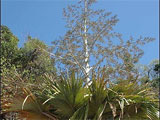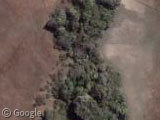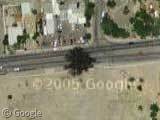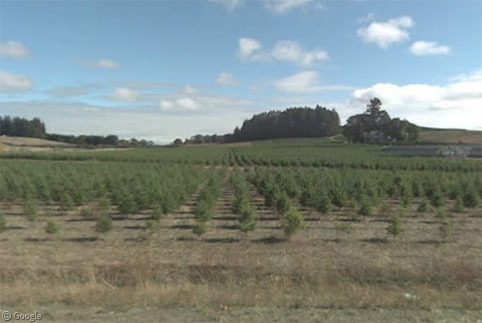Mysterious Self-Destructing Palm Tree
Thursday, 17th January 2008 by Alex Turnbull
Scientists working with Kew gardens have today announced their discovery of a massive "self-destructing palm tree" in Madagascar. The tree has a bizarre unusual reproductive cycle, whereby after around 50 years of growth, the process of flowering actually kills the tree!
the colourful display and the production of fruit is so taxing that the nutrient reserves of the palm run dry as soon as it fruits and the entire tree collapses and dies.
The story has been reproduced in numerous articles today, all of which mentioned this little morsel from the original press release:
The plant is so massive, it can even be seen on Google Earth.
And yet not ONE of the many, many, many, many, many reporters managed to include a link to the location of the tree, or even the co-ordinates! And the reason of course, is that none of them actually bothered to check whether you really can see this tree or not.
Fortunately the team at Google Sightseeing don't subscribe to such lazy reporting methods, and we can EXCLUSIVELY REVEAL the location of the Mysterious Self-Destructing Palm Tree!
Um, hang on, that's just a forest. Apparently it's the one in the middle, let's zoom in a bit...
Right... If only it looked a little more interesting, eh? 😉
Thanks to Bronwyn at Kew gardens and readers Michael Chung and Marc Wintle.







It was my first thought when I read about the tree. I then thought: it isn’t actually that unusual to be able to see a tree on Google Earth, is it? All the trees near my home are clearly identifiable, for a start. We could also get into the Great Wall of China debate again over what seeing something from space actually means!
I was expecting a Pheonix like tree, one that blows up in a ball of flames and regrows, only to repeat the cycle. Now that, that would be a good tree!
Why is the thumbnail of the palm cropped in such a way that half the palm tree is lost? Or is the non-palm-looking tree in the background the one we’re talking about?
koen, that’s actually the top part of the tree. It looks like a palm at the bottom, and has that huge sprouty thing sticking out the top. This image might make things a little clearer:
EDIT: wow, I didn’t think posting that image would work!
It’s a good job the plant still has time to reproduce, otherwise it would go extinct. It looks like some sort of cross between two trees.
Hey Jonathan – you got quoted in the New York Times!
http://thelede.blogs.nytimes.com/2008/01/17/can-you-really-see-it-from-space/
@alex: Oooh wow, that’s a pretty cool tree!
Too bad I can’t edit my post, but I just wanted to add that you guys got treated quite well by the new york times! Not too sure what a yeoman’s job is though, but I’m sure it’s a compliment.
According to ‘Yankel’ at phrases.org.uk, a yeoman’s job means:
“Doing a good job all round; working hard and competently. The phrase is associated with work that doesn’t require specialized skills and can be done well by tackling the task industriously.”
😀
I find it a bit disconcerting that the New York Times are reading my frankly inane posts. It could jeopardise my Pulitzer Prize nomination if they knew my true identity!
Keep up the Yeomanry lads! 😀
In the photo it looks like it is at the edge of the trees and not in the middle.
It’s worth pointing out that the original news story, with lots of further information and photographs, can be found at http://www.kew.org/scihort/news/new_palm_genus.html
Nature really is weird. But this palm tree is not the only one like this. Many plants, like Century plants (Agave) and bromeliads (Bromeliaceae) do not flower until a long time. After they do it, they die, but not without having produced basal shoots (smaller plants growing at the foot of the big one) before. Other plants which have a similar (but not the same) development are Blanket flowers (Gaillardia), a perennial plant used in gardens. It flowers non-stop from June to September. After that, the flowering has taken so much energy that the plant looks like it was about to die.
re: NYT blog – from their selection of Google Sightseeing highlights, it appears they didn’t get past the first page. Lazy NYT … lots more interesting (weird) stuff in the archives … :}